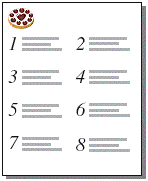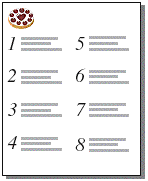Setting up to print records in columns
You can set up a layout to print (or preview)
records in columns, for example, for a directory of names and addresses. This is in contrast to a List view or Report
layout, which arranges
fields in columns.
When you set up records to print in columns, all the information for one record is printed together in a block (much like on a label), then all the values for the next record are printed together, and so on. You can specify the order of records — either across rows or down columns.
Across rows first | Down columns first |
| |
You only see multiple columns in Layout and Preview modes and when you print (not in Browse mode or Find mode).
To set up columns in a layout:
1. Choose File menu > Print Setup (Windows), or File menu > Page Setup (OS X), confirm that your printer and paper settings are correct, and then click OK.
In
Preview mode, you can also click
Print Setup (Windows) or
Page Setup (OS X) in the
status toolbar.
FileMaker Pro considers the selected printer, and print or page setup information when it calculates margins and other measurements on the layout.
It's easiest to start with a
blank layout or a layout with no objects in the body part. See
Creating a layout.
4. Click the Printing tab.
5. Select Print in <n> columns, and then set the options described in the following table.
To | Do this |
Specify the number of columns | For Print in <n> columns, type a number between 1 and 99. |
Arrange records to flow across the page first (left to right a row at a time) | Select Across first. Use this option for reports like labels, to use the fewest number of rows and preserve label stock. |
Arrange records to flow down the page first (top to bottom a column at a time) | Select Down first. Use this option for reports like directories, where you usually read from top to bottom, column by column. |
6. Click OK.
On the layout, you see vertical lines indicating columns.
7. Place or arrange fields and other layout objects so they are contained within the sample column on the left.
Use
merge fields or fields or objects with
sliding enabled to fit more data into the width of a column. With either of these two features, fields can extend into the gray area of the second column, and blank space in fields is eliminated when you view or print data. See
Placing merge fields on a layout and
Removing blank spaces in printouts.
To change the width of columns:
The initial width of each column is calculated based on the paper size, orientation, and any margins you have set. To change the width of columns, do one of the following:
To | Do this |
Interactively adjust the width of the columns | Drag the right column boundary (the vertical dashed line at the right edge of the sample column). Note Because the page width is fixed, dragging the column boundary to the right does not increase the width of the printable area within each column (unless you previously narrowed the column width). Instead dragging the column boundary to the right creates a “gutter” margin between each column. This gutter margin is useful for creating space between columns, but it reduces the printable area within each column. |
Precisely measure and adjust the width of the columns | Click Inspector  in the layout bar. Click the Position  tab. Position the pointer over the right column boundary, hold down the mouse button (be careful not to drag the column width), and read the column Width value in the Size area. |
Notes
•If you change the number of columns, FileMaker Pro adjusts the width of the columns to fit within the width of the paper size you have defined, not including fixed margins. You may need to readjust fields to fit within the sample column.
•When you select
Down first, FileMaker Pro prints
subsummary parts the width of the column. If you've specified that a page break comes after the subsummary part, FileMaker Pro starts a new column (not a new page). With
Across first, FileMaker Pro prints subsummary parts the width of the page, and the specified page break starts a new page. See
Defining page breaks and numbering.



